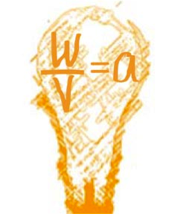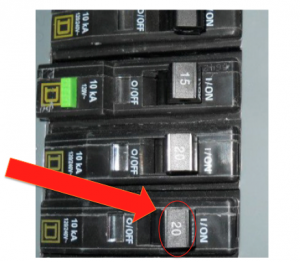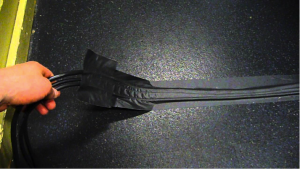Understanding basic electricity is imperative to prevent tripping breakers, starting fires, etc. when working with light kits.
The first step is figuring out how many amps (current) are necessary to power the wattage of the light(s), then check whether the circuit breaker (the switch at the panel) powering the outlets you’re using can support that many amps.
Most US circuits are 120 volts and can provide a flow of 15amps or 20amps (some circuits—specifically for appliances—can power more, but their outlets may not be the 3-pin grounded plugs necessary for most lights). Most homes or small offices will have 100-150amp TOTAL power; older houses may have less.
Most circuits that power lights/outlets in a house are 15amp. Sometimes one 15amp circuit will power several rooms since they are usually lights/TVs and products that require less power. By code, GFCI outlets in bathrooms (the ones with reset buttons) should be on their own 20amp circuit because hair dryers, etc. require lots of power (these may also only be 15amp circuits). Also by code, most appliances in kitchens, such as a microwave, coffee maker, fridge, etc. will also be on their own 15amp or 20amp circuit.
To give you a sense of how many watts some common items require:
MacBook = 85 watts, requiring .85amps of power
30” LED = 50 watts, requiring .5amps of power
Microwave = 1000-2000 watts, requiring 1-20amps of power
DVD player = 15 watts, requiring .15amps of power
How Much Power?
Cinema Studies has three types of kits with various power requirements because they use tungsten bulbs (LED lights require very little power):
- Britek 1800 watt kit: this is the most common kit we have. Each light needs 300 or 600 watts, depending on your selected settings.
- Arri 1950 watt kit. This kit has a 1000w light, a 650w light, and a 300w light.
- Arri 1900 watt kit. This kit has two 650w lights and two 300w lights.
The Math:
Lights are ALWAYS “rigged” by paper load because it gives you a cushion. So, for the following equation, you divide your watts by 100 instead of the 120volts. The basic math is:
For practical application:
- Britek: 1800w/100v (use the 100 to get the “paper load” instead of actual load taken at 120v) = 16.4amps, but 18amp paper load. This means that it will take 18amps of power to run all these lights at 600watts (although actual power is 16.4). Say you have two at full 600w and 1 at 300w, then it will be 15amps needed.
- Arri 1950w kit: 1950w/100v = 19.5amps to power all the lights.
- Arri 1900w/100v = 19amps to power all the lights.
Powering the Lights
Now, will a circuit be able to power a kit?
The answer varies. But, once you do the math and know how many amps it takes, you need to go to the breaker panel and see how many amps are running through that circuit.
Let’s say you want to use a Britek at 1800w in a bedroom. This will take 15-18amps of power. Now, find the panel (this should be in the basement, utility closet, garage, or outside) and find the circuit breaker for that bedroom. Note that some rooms will have multiple circuits or circuit breakers that are not clearly labeled. Always check with the person who owns/manages the property.
In the image above, notice it’s a 15amp circuit and will NOT power this kit without tripping the breaker. You will have to power some lights from an outlet on another circuit, or maybe not. You can definitely use this kit if some lights are powered at 300w, though.
Say you want to run the Arri 1900w kit that takes 19amps to run those lights. You can find a nearby bathroom and plug it into the GFCI outlets. You look at the breaker (pictured above) and it’s a 20amp circuit. It WILL power this kit.
When using the Arri 1950w kit, your best bet is to run the 1000w light on its own circuit and the other two lights on a different 15amp circuit. Try to run the 100w light from the kitchen or a bathroom circuit. Although you can power this on a 20amp circuit, any additional amperage use on that circuit (i.e. “source” lights) will cause the circuit to trip.
Notes
- BEFORE you set up an elaborate light scheme and trip a circuit, evaluate your power needs.
- When you scout locations, evaluate your power options BEFORE production days.
- Note that if you shoot outside and run a 200ft extension cord, that power is LOST over distance and you may not have enough power (you can work around this but it’s too complicated and requires some expertise).
- Some rooms may have 20amp circuits. If they have outlets that look like the image below (with the “T”), this stands for 20amp.
- ALWAYS rig your lights using the paper load.
- Work with the homeowner or property manager who knows where the breaker panel is. Eugene has some CRAZY electrical situations and often unmarked panels. NEVER just go into a panel unless it’s your property!!!
- Always tape down any extension cords across doorways, thresholds, etc. ALWAYS use gaffer’s tape; NEVER use duct tape.
- If you trip a breaker then go back to the panel and find the switch (if you don’t know where the switch is, it should be the only switch that is not in the on position and is, in fact, between the on and off. Push the switch to the off position; you should hear a click. Then, turn it back on. You have reset the breaker. Now, re-evaluate your light setup and run a light to another circuit.
- Be CAREFUL.
- Be SMART.
This page was written by Andre´ Sirois for the University of Oregon Cinema Studies Program and is published under Creative Commons license (CC BY NC SA 3.0)







